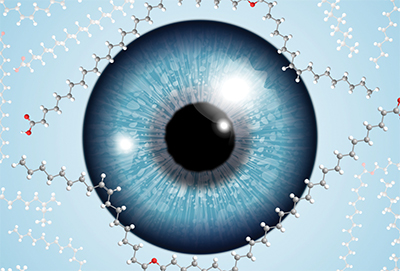JLR: Finding the structure of a lipid that keeps our tears clear
Because humans evolved from the sea, we carry a little of it with us to stay alive. Salt water makes up the cytoplasm in our cells, the plasma in our blood and the tears in our eyes.
 This image by first author Sarah Hancock shows an iris surrounded by the lipid she and colleagues in the Blanksby and Mitchell labs characterized by mass spectronomy.Journal of Lipid Research
This image by first author Sarah Hancock shows an iris surrounded by the lipid she and colleagues in the Blanksby and Mitchell labs characterized by mass spectronomy.Journal of Lipid Research
But water alone isn’t enough to keep the eye from drying out. A microscopically thin film of oils known as the lipid layer protects the tear film from evaporating. In the August issue of the Journal of Lipid Research, the structure of a key long-chain lipid in this layer. Their finding may be used to improve treatments for dry eye.
Although the long-chain lipids in question make up just 5 percent of the tear-film lipid layer, they play an important role in vision. Without them, earlier studies showed, the lipid layer would resemble an oil slick atop a puddle.
“This clearly wouldn’t be satisfactory for you to look through,” said , a professor at the Queensland University of Technology who led the research team in this study.
Blanksby saw the earlier research in Langmuir troughs carried out by others as a prompt to determine the precise structure of the ultra-long-chain lipids of the eye.
The tear-film lipid layer comes from meibum secreted by the lower eyelid. Scientists can collect meibum samples from brave volunteers by running a small spatula gently over their lower lids, but it is difficult to obtain enough for conventional assays like nuclear magnetic resonance spectroscopy.
Complicating matters, the team needed to differentiate between isomers. They knew the long lipids were made of two fatty acids but not whether they were joined end-to-end or branched, a question conventional mass spectrometry couldn’t answer.
Fortunately, Blanksby and colleague of the University of Wollongong have spent the last decade fine-tuning mass spectrometric techniques to characterize lipids.
“We were able to bring a unique toolbox to bear,” said Blanksby. “Some of these techniques may not exist outside Todd’s and my laboratory.”
By incorporating established approaches, such as ozonolysis, into a mass spectrometry workflow, the team determined that the most abundant of the ultra-long lipids is joined end-to-end, and they pinpointed each of its double bonds. The mass spectrometrists handed off the structure to chemist colleagues led by Michael Kelso, who developed a method to synthesize it.
The team now is working with industry partner Allergan, which cofunded the research with the Australian Research Council, on incorporating the new synthetic long-chain lipid as a component of drops for dry eye. While our knowledge of the lipid layer has expanded, according to Blanksby many eye drops still use mineral oil.
“This type of work provides a framework to produce a product that mimics, and is based on, the actual components that are present in human tears,” he said.
Blanksby hopes that by creating a better match to the real tear film, blurriness and other side effects of using eye drops can be alleviated.
Enjoy reading ASBMB Today?
Become a member to receive the print edition four times a year and the digital edition monthly.
Learn moreGet the latest from ASBMB Today
Enter your email address, and we’ll send you a weekly email with recent articles, interviews and more.
Latest in Science
Science highlights or most popular articles

ApoA1 reduce atherosclerotic plaques via cell death pathway
Researchers show that ApoA1, a key HDL protein, helps reduce plaque and necrotic core formation in atherosclerosis by modulating Bim-driven macrophage death. The findings reveal new insights into how ApoA1 protects against heart disease.

Omega-3 lowers inflammation, blood pressure in obese adults
A randomized study shows omega-3 supplements reduce proinflammatory chemokines and lower blood pressure in obese adults, furthering the understanding of how to modulate cardiovascular disease risk.

AI unlocks the hidden grammar of gene regulation
Using fruit flies and artificial intelligence, Julia Zeitlinger’s lab is decoding genome patterns — revealing how transcription factors and nucleosomes control gene expression, pushing biology toward faster, more precise discoveries.

Zebrafish model links low omega-3s to eye abnormalities
Researchers at the University of Colorado Anschutz developed a zebrafish model to show that low maternal docosahexaenoic acid can disrupt embryo eye development and immune gene expression, offering a tool to study nutrition in neurodevelopment.

Top reviewers at ASBMB journals
Editors recognize the heavy-lifters and rising stars during Peer Review Week.

Teaching AI to listen
A computational medicine graduate student reflects on building natural language processing tools that extract meaning from messy clinical notes — transforming how we identify genetic risk while redefining what it means to listen in science.

